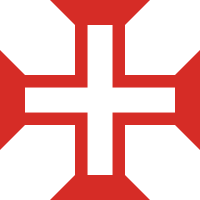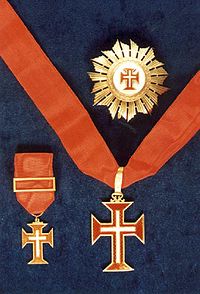
Back Ордэн Хрыста Byelorussian Orde de Crist Catalan Řád Kristův Czech Christusorden (Portugal) German Ordeno de Kristo Esperanto Orden de Cristo Spanish Kristuksen veljeskunta Finnish Ordre du Christ (Portugal) French Orde de Cristo Galician Krisztus Lovagrendje Hungarian
| Military Order of Christ Ordem Militar de Cristo | |
|---|---|
 Order of Christ Cross, also known as the Portuguese Cross | |
| Type | Honorific Order |
| Established |
|
| Country | |
| Religious affiliation | Roman Catholicism |
| Ribbon | Red |
| Eligibility | Portuguese and foreigners; military and civilian |
| Awarded for | Relevant services to the country in the exercise of functions related to the government or public administration |
| Status | Currently awarded |
| Grand Master | President of the Portuguese Republic |
| Chancellor | Jaime Gama |
| Precedence | |
| Next (higher) | Order of the Tower and Sword |
| Next (lower) | Order of Aviz |
 Decorations of the Order | |
The Military Order of Christ[a] is the former order of Knights Templar as it was reconstituted in Portugal. Before 1910, it was known as the Royal Military Order of Our Lord Jesus Christ,[b] and the Order of the Knights of Our Lord Jesus Christ.[c] It was founded in 1319,[1][2] with the protection of King Denis of Portugal, after the Templars were abolished on 22 March 1312 by the papal bull, Vox in excelso, issued by Pope Clement V.[3][4] King Denis refused to pursue and persecute the former knights as had occurred in most of the other sovereign states under the political influence of the Catholic Church.
Heavily swayed by Philip IV of France, Pope Clement had the Knights Templar annihilated throughout France and most of Europe on charges of heresy, but Denis revived the Templars of Tomar as the Order of Christ, largely for their aid during the Reconquista and in the reconstruction of Portugal after the wars. Denis negotiated with Clement's successor, John XXII, for recognition of the new order and its right to inherit the Templar assets and property. This was granted in a papal bull, Ad ea ex quibus, on 14 March 1319.[5]
There exists also a parallel Supreme Order of Christ of the Holy See, the Order of Christ of the House of Orléans-Braganza, and the Order of Christ of Kongo.[6]
Cite error: There are <ref group=lower-alpha> tags or {{efn}} templates on this page, but the references will not show without a {{reflist|group=lower-alpha}} template or {{notelist}} template (see the help page).
- ^ Matthew Anthony Fitzsimons; Jean Bécarud (1969). The Catholic Church today: Western Europe. University of Notre Dame Press. p. 159. ISBN 978-0268003074.
- ^ Helen J. Nicholson (2004). The Crusades. Greenwood Publishing Group. p. 98. ISBN 978-0-313-32685-1.
- ^ Robert Ferguson (2011). The Knights Templar and Scotland. History Press Limited. p. 39. ISBN 978-0-7524-6977-5.
- ^ Jochen Burgtorf; Paul F. Crawford; Helen J. Nicholson (2013). The Debate on the Trial of the Templars (1307–1314). Ashgate Publishing, Ltd. p. 298. ISBN 978-1-4094-8102-7.
- ^ F. A. Dutra, "Dinis, King of Portugal", in Medieval Iberia: An Encyclopedia (Routledge, 2003), p. 285.
- ^ Curto, José C.; Lovejoy, Paul E. (2004). Enslaving Connections: Changing Cultures of Africa and Brazil During the Era of Slavery. Humanity Books. p. 261. ISBN 978-1-59102-153-7.
© MMXXIII Rich X Search. We shall prevail. All rights reserved. Rich X Search